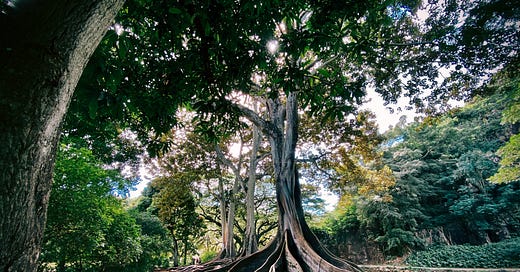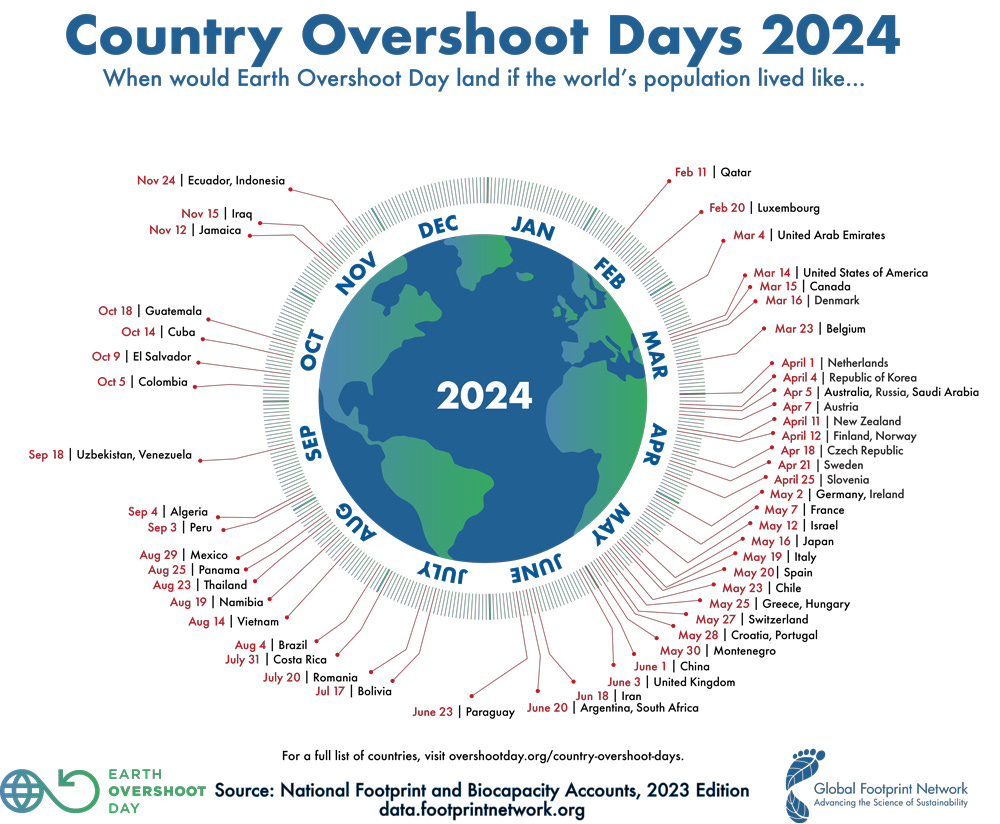Five Things I Wish Everyone Knew
As Australia reaches its Earth Overshoot Day I reflect on some of the things I wish everyone knew.

Today, Friday 5th April, is Earth Overshoot Day in Australia. That is, the day in which, if the whole world lived like Australians, we would have exhausted all of the resources and services the planet can provide in one year. For the remainder of the year we are stealing from future generations and lower-consuming nations.
If the whole world lived like Australians we would need four planet Earths. As it is, we need 1.7 planet Earths to meet our current global consumption:
I’ve known this day was coming, but it still fills me with a sinking feeling. How do I look my children in the eye when I know that we are living in a system that will cause them so much harm?
We are stealing the future, selling it in the present, and calling it GDP.
- Paul Hawken
So, I’m going to share what I know, and hope that others share what they now know, in an attempt to reach a social tipping point where this extractive, destructive economy becomes one that puts people and the planet at its heart, ultimately supporting, rather than eliminating, life on Earth.
Here it is. The five things I wish everyone knew:
1. We’re REALLY far from limiting warming to 2 degrees, let alone 1.5 degrees
The below image from Climate Action Tracker shows both that we are already at 1.3°C of warming and just how far away we are from limiting warming to below 2°C, with current policies getting us to a mid-range of 2.7°C above pre-industrial levels. Given what is at stake, the highest point of that range should be at or below 2°C. Having the lowest point even higher than 2°C is woefully inadequate:
The policies that have been implemented are a long way from where we need to be. Wealthy nations - like Australia - should be aiming to reduce emissions by 75% by 2030 (the current Australian Labor government has a target of 43% reduction and are relying on controversial carbon offsets for much of it). It is worth noting here that the Paris Agreement target of holding “global temperature increase to well below 2°C above pre-industrial levels and pursue efforts to limit it to 1.5°C above pre-industrial levels” is a political target, rather than a scientific one. The ideal amount of warming is 0°C, where we would maintain the climate that humanity has enjoyed for the last 10,000 years or more, rather than risking warming which may lead to more warming (more on that later).
2. We are STILL heading in the wrong direction
Despite three decades of global conventions on climate change, Greenhouse Gas (GHG) emissions are now 60% higher than they were in 1990, and we have put more GHGs into the atmosphere since the first IPCC report was released in 1990 (i.e., knowing about the problem) than in all of human history prior. Further proof that we are not doing what is needed is that GHG emissions reached the highest ever levels in 2023. This is not surprising as we are trying to solve our ecological crises while growing our economies, the very thing that requires more energy. Energy use and economic growth are very closely correlated (virtually 1:1) and so the more we grow our economies the harder it is to wean ourselves off fossil fuels.
3. Warming leads to more warming, which we won’t be able to control
If the world warms beyond 2°C it is highly likely that we will activate ‘tipping points’ in the Earth’s system that will take warming out of our hands, leading to a ‘Hothouse Earth’. There is a risk of this even at 1.5°C of warming.
Some elements of the Earth’s system have already tipped - such a the Arctic: ice free summers are now unavoidable and expected by 2030. Furthermore, some of these ‘tipping points’ can have feedback loops that exacerbate warming. The dark blue ocean of an ice-free Arctic, for example, will absorb more heat than white ice which reflects the sun rays back into the atmosphere, meaning that an ice-free arctic will heat the Earth further.
The late Earth Systems scientist, Professor Will Steffen, advised that getting GHG emissions down fast has to be “the primary target of policy and economics” akin to a “wartime footing”. In this short video Steffen describes the challenge we face:
4. Climate change is one of many problems we need to focus on
Climate change is only one of six planetary boundaries we are transgressing. Earth system scientists say that “crossing certain biophysical thresholds could have disastrous consequences for humanity." In addition to climate change, we are also exceeding the planetary boundaries for novel entities (plastic pollution), biosphere integrity (species loss), land systems change, phosphorus and nitrogen run-off (mostly from agriculture) and freshwater change:

Given this, we must not have ‘carbon tunnel vision’ when solving our ecological crises. Some solutions to climate change can exacerbate the other planetary boundaries (especially technological solutions that require more mining in biodiversity hotspots).
What a terrible thing it would be to ‘solve’ climate change only to be have another planetary boundary lead to catastrophe.
5. There is more we can do, but we’re currently barely talking about alternatives, let alone actually doing them
We can do much more to limit warming, but it will require a fundamental re-think of how we are living. We can no longer pretend that the incrementalism we have been pursuing for decades is working. We need to face into the fact that an economic system that is predicated on growth is the root cause of our ecological crises:
… the three main challenges to humanity – climate change, the degradation of the biosphere and the growing inequalities between and among countries – were “just different facets of the same fundamental problem”.
This problem was the “neoliberal economic system” that spread across the world through globalisation, underpinning “high production high consumption lifestyles” and a “religion built not around eternal life but around eternal growth”.
- The late Professor Will Steffen, “‘Collapse of Civilisation is the Most Likely Outcome’: Top Climate Scientists”
What we could be doing that would be more effective than incrementalism is degrowing our material and energy throughput (by reducing our production and consumption) until we are back within the limits of the planet, illustrated in the chart below as a phase in reaching genuine sustainability:

Once we are back within the limits of the planet (that is, within the safe limits of of all nine planetary boundaries) we can maintain a steady-state economy where we are not consuming more resources or services than Earth can provide. Essentially this means providing everyone with universal public services, a reduced working week, a job guarantee and a basic-minimum income, and then democratically determining which industries we need to reduce and how we will do it. This article, titled ‘What Would It Look Like If We Treated Climate Change as an Actual Emergency?’ by Economic Anthropologist, Professor Jason Hickel, goes into more detail.

Despite many initial reactions to the term ‘degrowth’, a degrown economy doesn’t have to be awful, in fact, degrowth could very well mean more, especially when compared with the current trajectory we are on. Not more ‘stuff’, but more of the things that really matter: more nature, more time, more equity, as the above chart by Jennifer Wilkins illustrates. But most importantly, degrowth could mean more life for all of us: including our children, their children and the other-than human species that also call Earth home. What could be better than that?
This post was based on this X (formerly Twitter) thread of mine, which was seen by 419,000 people.
A few other random things that might be of interest:
This article was an excellent read by one of my favourite writers, Jag Bhalla: ‘How Best to Love Your Kids in a World on Fire?’
I’m really enjoying the book Ancient Futures by Helena Norberg-Hodge, looking at how Western-style development has changed the remote Himalayan village of Ladakh in ways that cannot be considered positive, and what we give up when we believe that the Western model of development is the ‘only’ or even ‘best’ way to live. There is an hour long documentary based on the book here.
In the book Ancient Futures, Norberg-Hodge describes how nothing was thrown away in traditional Ladakh society, and even the crushed kernels from their apricots would have the oil extracted from them and the remains turned into a cup that is used to turn spindles. It truly was a no waste society. Clothing that couldn’t be mended any further was used to hold soil for the agricultural walls they needed, and dung, including human ‘night soil’ was collected and used to fertilise the fields. It has really made me reflect on what we throw away that could be of use, starting with the oils in the skin and kernels of the fruit we eat. So, we’ve started making orange oil at home (as it isn’t apricot season in Sydney at the moment). It’s a (very) small thing, but its fun and my children find it interesting to see how our little experiment turns out.
If you are interested in learning more about degrowth you may find these Introduction to Degrowth slides useful.
If you are interested in learning more about social tipping points and how you can play a role in reaching them, PROJECT TIPPING POINT may be of interest to you. The code LAUNCH65 will give you a 65% discount.








Excellent summary of our plight. I so admire your commitment
I am a private scientist focusing on energy. I will be introducing my newly developed wind and solar advancements that will make both base load capable. This means local communities can build their own power generation plants and the cost of electricity will drop 95% Watch for us on Indiegogo this Spring.